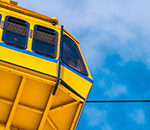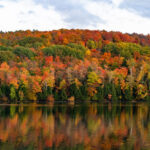At 14,410 feet, Mount Rainier is Washington’s towering fourteener (14er), nestled between many other prominent peaks in Rainier National Park. Despite being one of the most dangerous volcanoes in the world and one of the most treacherous alpine climbs in the United States with its many crevasses and glaciers, Mount Rainier is a popular mountaineering challenge among North Americans; on average, it hosts 10,000 summit attempts per year, only half of which are successful due to harsh weather conditions and frequent avalanches. One climber captured this photo of his team descending the mountain along the Disappointment Cleaver route, warmed by one of Rainier’s famous sunrises:
No, the curvature of the horizon in this photo is not natural. Rather, this effect was accomplished through the use of a fisheye lens, an extreme wide-angle lens that adds creative distortions to photographs. The fisheye lens was originally developed for meteorology and astrophotography, since it allowed meteorologists to capture the formation of clouds and astrophotographers to capture the spherical shape of planets in conjunction with the movement of stars.
While the fisheye lens has a controversial reputation among landscape photographers, take a look at the photograph without spherical distortion:
Perhaps the fisheye lens does breach the bounds of reality, but spherical distortion clearly benefits the shot, infusing the photo with a certain vastness that shouts, “We really are on top of the world!”
Like This Article?
Don't Miss The Next One!
Join over 100,000 photographers of all experience levels who receive our free photography tips and articles to stay current:







Leave a Reply